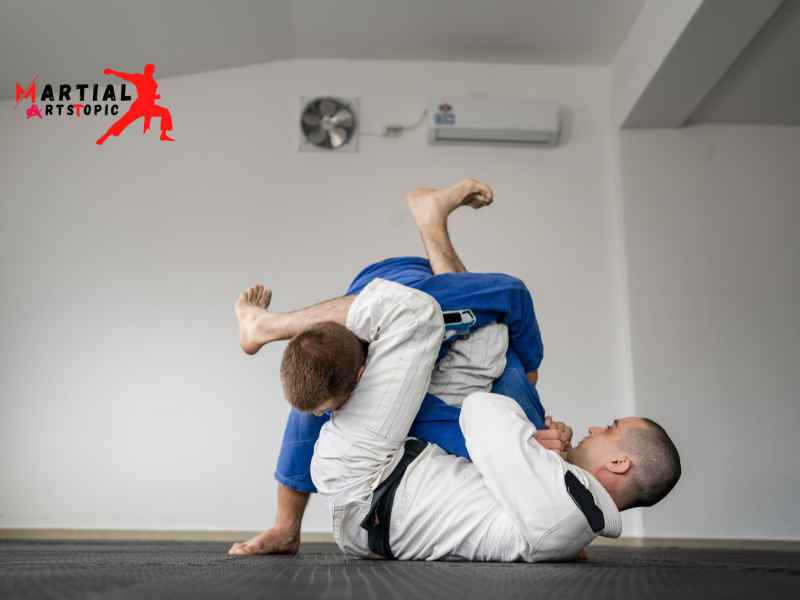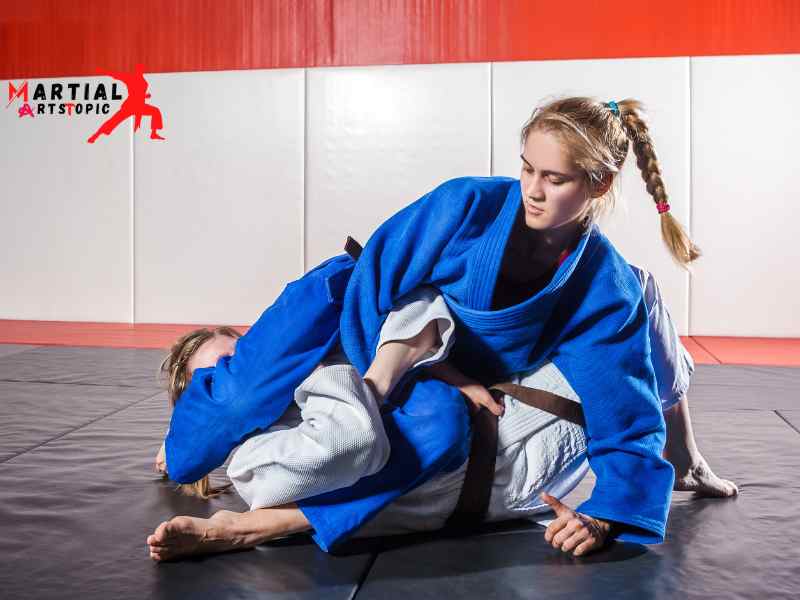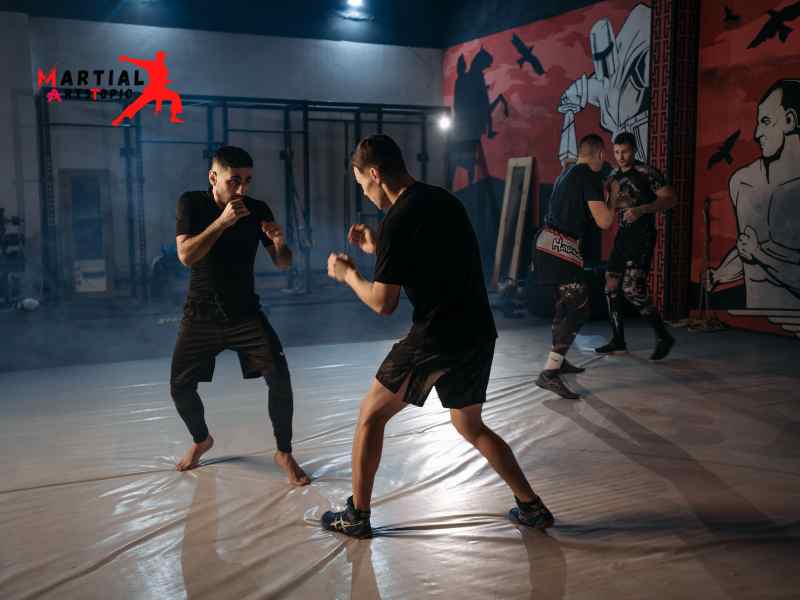
The History and Evolution of Submission Wrestling
Submission wrestling, also known as submission grappling or simply grappling, is combat sports that focuses on ground-based grappling techniques and submissions. It combines elements of several martial arts, including Brazilian Jiu-Jitsu, Judo, Sambo, and Catch Wrestling.
Origins of Submission Wrestling
We can trace the roots of submission wrestling back to ancient times when various forms of grappling were practiced in different cultures. In ancient Greece, the sport of Pankration emerged, combining wrestling and striking techniques. Pankration was considered one of the most brutal combat sports of its time, with fighters utilizing joint locks and chokeholds to submit their opponents.
In Japan, a similar form of grappling known as Jujutsu flourished. Jujutsu focused on using an opponent’s energy against them, employing joint locks, throws, and pins. This martial art laid the foundation for contemporary submission wrestling techniques.
The Birth of Brazilian Jiu-Jitsu

The modern development of submission wrestling owes much to the creation of Brazilian Jiu-Jitsu (BJJ) in the early 20th century. Mitsuyo Maeda, a Japanese judoka, immigrated to Brazil and taught his art to Carlos Gracie, who then passed it on to his brothers. The Gracie family played a pivotal role in refining and popularizing BJJ as an effective combat sport.
What set BJJ apart from other grappling arts was its emphasis on ground fighting and submissions. BJJ practitioners discovered that by utilizing leverage and technique, they could overcome larger and stronger opponents. This revolutionized the way martial arts were perceived, leading to the rise of mixed martial arts (MMA) and the popularization of submission wrestling worldwide.
The Influence of Catch Wrestling and Judo
While BJJ was gaining prominence in Brazil, catch wrestling and judo were making significant contributions to the evolution of submission wrestling in other parts of the world.
Catch wrestling, developed in Great Britain in the 19th century, was known for its focus on submission holds and pinning techniques. It heavily influenced the early years of professional wrestling and had a lasting impact on submission wrestling techniques.
Judo, developed by Jigoro Kano in Japan, introduced the concept of randori, or free practice, which allowed practitioners to test their skills against resisting opponents. The incorporation of judo throws and groundwork further enriched the art of submission wrestling, providing a broader arsenal of techniques to practitioners.
The Rise of Submission Wrestling as a Sport
In the 1990s, submission wrestling gained widespread recognition with the Ultimate Fighting Championship (UFC). The UFC was a platform that showcased different martial arts styles against each other, and it quickly became evident that submission wrestling was a dominant force. Royce Gracie, a BJJ practitioner, won the first few UFC tournaments, cementing the effectiveness of submission wrestling in real-world combat.
Following the success of the UFC, submission wrestling tournaments and organizations began to emerge around the world. The International Brazilian Jiu-Jitsu Federation (IBJJF) was established to regulate BJJ competitions, while other organizations such as ADCC (Abu Dhabi Combat Club) focused specifically on submission wrestling.
In recent years, submission wrestling has further developed with the integration of techniques from other grappling arts and the development of new strategies. Practitioners are constantly exploring original positions, submissions, and strategies to gain an advantage over their opponents.
Training and Conditioning for Submission Wrestling

Unlock Your Full Potential are you ready to take your submission wrestling skills to the next level? Whether you’re a beginner or an experienced athlete, proper training and conditioning are essential for success in this dynamic and challenging sport.
Submission wrestling, also known as submission grappling, is a combat sport that combines elements of wrestling, Brazilian Jiu-Jitsu, and other grappling techniques. The goal is to submit your opponent through various joint locks and chokeholds. It requires not only technical proficiency but also physical strength, endurance, and mental toughness.
To excel in submission wrestling, you need to develop a well-rounded training and conditioning program that focuses on several key areas.
- Strength Training: Building overall strength is crucial for success in submission wrestling. Incorporating exercises like deadlifts, squats, bench presses, and pull-ups into your routine will help develop functional strength and enhance your grappling abilities. Additionally, specific exercises targeting the muscles used in submission holds, such as the back, shoulders, and core, should be included.
- Endurance Training: Submission wrestling matches can be physically demanding and can last for extended periods. Therefore, improving your endurance is vital. Incorporate high-intensity interval training (HIIT), circuit training, and cardiovascular exercises like running or swimming into your routine. These exercises will help improve your cardiovascular fitness, allowing you to maintain a high level of performance throughout the match.
- Flexibility and Mobility: Submission wrestling requires a wide range of motion and flexibility. To optimize your performance and reduce the risk of injury, incorporate stretching exercises and mobility drills into your training regimen. This will improve your joint mobility and allow you to execute techniques with greater ease.
- Technique Training: While strength and endurance are important, technique plays a significant role in submission wrestling. Regularly practicing and refining your grappling techniques, such as takedowns, escapes, and submissions, is essential. Consider working with a qualified coach or attending structured training sessions to master the intricacies of the sport.
- Mental Conditioning: Submission wrestling is as much a mental game as it is a physical one. Developing mental toughness, focus, and resilience will give you a competitive edge. Explore techniques such as visualization, meditation, and mindfulness to enhance your mental conditioning and maintain composure during intense matches.
The Art of Submission Wrestling: Tips and Techniques
If you’re a fan of combat sports or looking to improve your self-defense skills, submission wrestling is a discipline worth exploring. Also known as submission grappling, or simply grappling, this dynamic form of martial arts focuses on controlling opponents and forcing them into submission through various techniques. In this comprehensive guide, we will delve into the world of submission wrestling, providing you with valuable tips and techniques to help you master this art.
What is Submission Wrestling?
Submission wrestling is a hybrid martial art that combines techniques from various grappling arts, including Brazilian Jiu-Jitsu, Judo, Sambo, and catch wrestling. Unlike other combat sports, where victory is determined by knockout or points, submission wrestling emphasizes the submission of an opponent through joint locks, chokes, or other grappling maneuvers.
Tips for Success in Submission Wrestling
- Learn the Basics: Before diving into the advanced techniques, it is crucial to develop a firm foundation in the basics of submission wrestling. Focus on mastering essential positions such as mount, guard, side control, and back control. Understand how to maintain control and transition between these positions seamlessly.
- Enhance Your Strength and Conditioning: Submission wrestling requires physical strength and stamina. Incorporate strength training exercises that target the muscles used in grappling, such as the core, back, and legs. Additionally, incorporate cardiovascular exercises to improve your endurance and overall conditioning.
- Study the Techniques: Familiarize yourself with the various submission holds, joint locks, and chokes commonly used in submission wrestling. Take the time to understand the mechanics behind these techniques, as well as the optimal situations to apply them during a match or self-defense scenario.
- Develop Your Ground Game: Submission wrestling primarily takes place on the ground. Focus on improving your ground game by drilling positional escapes, sweeps, and submissions. Work on maintaining a dominant position while constantly looking for opportunities to finish the fight.
- Train with Partners of Different Skill Levels: Training with partners of varying skill levels is essential for growth in submission wrestling. By practicing with more experienced practitioners, you can learn from their expertise and develop your skills faster. Training with less experienced partners allows you to work on your technique and develop your teaching abilities.
- Attend Competitions and Open Mats: Participating in submission wrestling competitions and attending open mat sessions provides valuable experience and exposure to different styles and techniques. It also allows you to gauge your progress and identify areas that need improvement.
- Focus on Defense: While offense is important, defense is equally crucial in submission wrestling. Learn effective defensive techniques to avoid being caught in a submission hold. Understand the importance of maintaining a calm and composed mindset, even in challenging situations.
- Mental Preparation: Submission wrestling is as much a mental game as it is a physical one. Develop mental toughness, focus, and discipline through meditation, visualization, and mental conditioning exercises. Cultivate a mindset of perseverance and resilience to overcome challenges and setbacks.
Safety and Injury Prevention in Submission Wrestling

Submission wrestling, also known as grappling or submission grappling, is a dynamic and physically demanding sport that requires strength, technique, and agility. As with any combat sport, there is a risk of injury involved. However, by implementing proper safety measures and injury prevention strategies, practitioners can minimize the risk and enjoy this exciting sport to the fullest.
Essential tips and techniques to ensure safety and injury prevention in submission wrestling. Whether you are a seasoned grappler or a beginner looking to get started, these guidelines will help you stay safe on the mats.
- Warm Up and Stretching: Before engaging in any physical activity, it is crucial to warm up your body properly. A thorough warm-up routine increases blood flow to your muscles, making them more flexible and less prone to injury. Dynamic stretches, such as arm circles, leg swings, and torso rotations, are excellent for preparing your body for the intense movements involved in submission wrestling.
- Learn Proper Technique: One of the most effective ways to prevent injuries in submission wrestling is by mastering proper technique. Understanding how to execute moves correctly not only helps you perform better, but also reduces the risk of accidents and injuries. Seek guidance from experienced coaches and instructors who can teach you the fundamentals and emphasize the importance of technique over strength.
- Gradual Progression: As with any physical activity, it is crucial to progress gradually in submission wrestling. Avoid pushing yourself too hard or attempting advanced techniques before you are ready. Building a solid foundation and accumulating the intensity of your training will reduce the risk of overuse injuries and ensure a safer grappling experience.
- Protective Gear: While they typically practice submission wrestling without protective gear, there are certain accessories that can help prevent injuries. Mouth guards, ear guards, and knee pads are some examples of protective gear that can provide additional safety during training and competitions. Consult with your coach or trainer to determine if they recommended any protective gear for your specific needs.
- Listen to Your Body: Pay close attention to your body’s signals during training sessions. If you experience any pain, discomfort, or fatigue, it is essential to take a break and rest. Pushing through pain can lead to more severe injuries and longer recovery periods. Rest and recovery are crucial aspects of injury prevention, allowing your body to heal and rejuvenate.
- Cross-Train and Condition: Incorporating cross-training and conditioning exercises into your training regimen can enhance your overall fitness level and reduce the risk of injuries. Activities such as strength training, cardiovascular exercises, and flexibility training help improve your physical attributes and make you more resilient on the mats.
- Proper Nutrition and Hydration: Good nutrition and hydration are vital for optimal performance and injury prevention. Maintain a well-balanced diet that includes an adequate amount of protein, carbohydrates, and healthy fats to support your training. Staying hydrated throughout your training sessions is also essential to prevent muscle cramps and fatigue.
- Respect Your Training Partners: Submission wrestling is a collaborative sport that relies on training partners to practice techniques and improve skills. It is crucial to treat your training partners with respect and prioritize their safety. Avoid using excessive force or applying submissions without control, as this can lead to unnecessary injuries.
Submission Wrestling for Women: Empowerment and Self-Defense
In recent years, the popularity of submission wrestling has been on the rise, and it’s not just for men. Women all over the world are discovering the benefits of this empowering and effective martial art. Submission wrestling provides women with a unique opportunity to build strength, gain confidence, and learn essential self-defense skills.
Submission wrestling, also known as grappling or submission grappling, is a combat sport that focuses on ground fighting techniques. Unlike traditional martial arts, submission wrestling does not involve striking or kicking opponents. Instead, it emphasizes grappling, joint locks, and holds to gain control over an opponent and force them to submit or tap out.
Empowerment through Physical Strength
One of the most significant benefits of submission wrestling for women is the development of physical strength. Through consistent training, women can build muscle, increase endurance, and improve overall fitness levels. This newfound physical strength not only enhances their performance in the sport but also carries over into everyday life, making them feel more confident and capable.
Boosting Self-Confidence
Submission wrestling provides women with a sense of empowerment and boosts self-confidence. As they learn and master various techniques, women gain a deep understanding of their bodies’ capabilities and become more aware of their strengths. This newfound self-assurance extends beyond the mat and positively affects other aspects of life, such as work, relationships, and personal goals.
Self-Defense Skills
Besides physical strength and confidence, submission wrestling equips women with essential self-defense skills. By learning how to control and neutralize opponents in close combat situations, women can effectively protect themselves if faced with real-life threats. Submission wrestling teaches techniques that leverage an opponent’s strength against them, making it an ideal martial art for women who may face physically larger or stronger attackers.
A Supportive and Inclusive Community
Submission wrestling offers women a supportive and inclusive community where they can train and grow together. Unlike some other combat sports, submission wrestling emphasizes respect, camaraderie, and fair play. Women who join submission wrestling classes often find themselves surrounded by like-minded individuals who encourage and motivate each other to excel.
Submission Wrestling: Breaking Stereotypes
Submission wrestling not only promotes physical fitness and self-defense but also challenges gender stereotypes. By participating in a sport traditionally dominated by men, women are breaking barriers and paving the way for future generations. Women who engage in submission wrestling inspire others to push past societal expectations and embrace their physical and mental capabilities.
How Submission Wrestling Can Improve Your Self-Defense Skills
Skills self-defense is a vital skill that everyone should possess in today’s world. Whether you’re a man or woman, young or old, knowing how to defend yourself can make a significant difference in dangerous situations. While there are various forms of martial arts and combat sports that claim to teach self-defense, one discipline that stands out is submission wrestling.
Submission wrestling, also known as submission grappling, or simply “grappling,” is a combat sport and martial art that focuses on ground fighting and submission holds. Unlike other martial arts that involve striking techniques, submission wrestling emphasizes grappling techniques such as holds, locks, and chokes to submit opponents.
- Practical Techniques for Real-World Scenarios: Submission wrestling equips you with practical techniques that are highly effective in real-world self-defense situations. Unlike many traditional martial arts that rely on complex moves or striking techniques, submission wrestling focuses on controlling and subduing opponents on the ground. By learning submissions and grappling techniques, you will gain the ability to neutralize and overcome adversaries, even in close-quarters combat scenarios.
- Increased Confidence and Mental Toughness: One of the most significant benefits of practicing submission wrestling is the boost in self-confidence and mental toughness it provides. As you train and become proficient in submission holds and techniques, you will develop a sense of self-assuredness that comes from knowing you can defend yourself in various situations. Additionally, the mental toughness cultivated through the rigorous training in submission wrestling will enable you to remain calm and focused, even in high-pressure self-defense encounters.
- Enhanced Physical Fitness and Conditioning: Submission wrestling is an intense and physically demanding activity that requires strength, agility, and endurance. Regular training in submission wrestling will improve your overall physical fitness, enhancing your strength, flexibility, and cardiovascular endurance. This increased physical conditioning will directly translate into improved self-defense capabilities, allowing you to react swiftly and effectively when faced with dangerous situations.
- Mental Sharpness and Tactical Thinking: Submission wrestling is not solely about overpowering opponents physically; it also involves strategic thinking and mental sharpness. While engaged in a match or self-defense situation, you will need to anticipate your opponent’s moves, react quickly, and make split-second decisions. The mental agility developed through submission wrestling training will enable you to think tactically and adapt to changing circumstances, a valuable skill for self-defense.
- Stress Relief and Improved Focus: Engaging in submission wrestling offers a healthy outlet for stress relief and helps improve focus and concentration. The intense physical exertion and mental engagement required in submission wrestling can act as therapy, allowing you to release tension, clear your mind, and improve your overall well-being. By practicing submission wrestling regularly, you will find yourself better equipped to handle stressful situations and maintain focus in high-pressure scenarios.
From the Mats to the Cage: Transitioning to Submission Wrestling in MMA

Submission wrestling has become an integral part of mixed martial arts (MMA) training, with fighters realizing the immense value of mastering the art of grappling.
Submission wrestling, also known as submission grappling or simply grappling, focuses on techniques that aim to force an opponent to submit through joint locks or chokes. It is a combination of various grappling arts, including Brazilian Jiu-Jitsu (BJJ), Judo, and wrestling. While striking is undoubtedly crucial in MMA, the ability to control and dominate an opponent on the ground can often be the difference between victory and defeat.
One of the key aspects that makes submission wrestling so effective in MMA is its emphasis on positional control. By utilizing techniques such as takedowns, sweeps, and transitions, submission wrestlers can dictate the flow of the fight and neutralize their opponents’ striking abilities. This control is particularly valuable when facing opponents with strong striking backgrounds, allowing submission wrestlers to take the fight to their preferred domain.
Submission wrestling provides fighters with an array of submission holds that can be utilized to secure a victory. By mastering techniques such as armbars, rear-naked chokes, guillotines, and triangle chokes, fighters can force their opponents to tap out or risk serious injury. The ability to seamlessly transition between different submissions is a hallmark of submission wrestling, providing fighters with a versatile arsenal to exploit their opponents’ weaknesses.
So how can fighters successfully transition from the mats to the cage when it comes to submission wrestling?
First and foremost, it is crucial to develop a solid foundation in the fundamentals of grappling. This includes mastering basic takedowns, escapes, and control positions. Building a firm foundation will provide fighters with the necessary skills to execute more advanced techniques in high-pressure situations.
Training with experienced submission wrestlers and grappling specialists is also essential. Regular sparring sessions and live rolling will help fighters develop their timing, reflexes, and adaptability. Additionally, learning from those who have already found success in the cage will provide valuable insights and strategies for effectively applying submission wrestling techniques in MMA.
Another important aspect of transitioning to submission wrestling in MMA is adapting one’s game to the unique rules and constraints of the sport. Unlike traditional grappling competitions, MMA incorporates strikes and the constant threat of getting hit. This necessitates a more cautious approach to submissions, as leaving oneself vulnerable can result in devastating strikes from the opponent. Understanding when and how to set up submissions while minimizing risk is crucial for success in the cage.
Lastly, conditioning and physical strength cannot be overlooked when it comes to submission wrestling in MMA. The ability to maintain a high level of energy and explosiveness throughout a fight is crucial, as grappling can be physically demanding. Incorporating strength and conditioning exercises specific to grappling will help fighters build the necessary endurance and explosiveness to dominate their opponents.
Conclusion
Submission wrestling is an exhilarating combat sport that combines elements of grappling and submission techniques. It requires a high level of skill, technique, and physical conditioning. Throughout this content, we have explored the various aspects of submission wrestling, including its history, rules, and training methods.Submission wrestling offers practitioners the opportunity to challenge themselves both mentally and physically. It promotes discipline, perseverance, and respect for oneself and others. By mastering the art of submission wrestling, individuals can not only improve their self-defense skills but also enhance their overall fitness and well-being.
Furthermore, submission wrestling provides a platform for athletes to compete at various levels, from local competitions to international championships. It fosters a sense of camaraderie among participants and encourages the exchange of knowledge and techniques.
Whether you are a seasoned athlete or a beginner looking to embark on a new martial arts journey, submission wrestling offers a rewarding and fulfilling experience. Through dedication, hard work, and a commitment to continuous improvement, anyone can excel in this dynamic and challenging sport.
